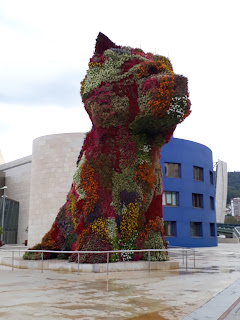LA ESPAÑA CELTA 2 - ASTURIAS (CELTIC SPAIN 2 - ASTURIAS)
La actuación el en vídeo
parece una sesión de música en cualquier pub irlandés en un pueblo en Clare o
Sligo o Kerry o Donegal. Músicos tocando juntos, disfrutando la música, el
ritmo, el ambiente.
Pero esta actuación
ocurrió en Cá Beleño en Oviedo, en la provincia española de Asturias. Y lo
curioso es que todos, excepto dos músicos irlandeses, son asturianos, del
norte de España.
Esa misma noche, en ese
pub asturiano/irlandés, el grupo también tocó la música tradicional asturiana.
Yo estaba ahí con mi amigo José, aficionado de la música tradicional
asturiana e irlandesa, y a veces no sabíamos muy bien si algunas melodías eran
irlandesas o asturianas. Hay una semejanza bastante fuerte entre las dos
formas de música.
|
The session in the video above looks like any music session in any Irish pub in Clare, Sligo, Kerry or Donegal; musicians playing together, enjoying the music, getting into the rhythm, the atmosphere. However, the gig took place in Cá Beleño in Oviedo, in the Spanish province of Asturias. And the curious thing is that all of the musicians, except two of them, are native Asturians, from the north of Spain. That same night, in that same Asturian/Irish pub, the group also played traditional Asturian tunes. I was there with my friend José, a fan of both Asturian and Irish music, and at times we didn't clearly know if some of the melodies were Irish or Asturian. There is a strong resemblance between the two types of music, going back to a shared Celtic influence. |
Banda de gaitas, Oviedo/ Bagpipe band, Oviedo
Como en Galicia, la
identidad celta existe aquí, aunque quizá no con tanta devoción. Lo que sí
hay aquí es una identidad regional bastante fuerte. No existe un movimiento
independentista en Asturias, como en Euskadi o en Cataluña – la gente no
tiene problemas con el estado español – pero hay una consciencia de que esta
región tiene elementos culturales únicos que no existen en el resto de
España.
Por ejemplo, hay una
lengua – el bable – que sólo existe en Asturias. No se sabe bien si es un
dialecto del castellano o una lengua en sí, pero la gente, mismo cuando está
hablando el español, utiliza palabras del bable en su día a día. Por lo que
yo he visto, tiene algún parecido con el gallego, y de ahí con el portugués.
Por ejemplo, hay un sonido en bable – como “sh” en inglés – que no se utiliza
tanto en español pero que es muy común en gallego y portugués. El nombre de
la ciudad asturiana Gijón, en bable, es Xixón, pronunciado algo como
“Shishon”.
|
Like in Galicia, the Celtic identity exists here in Asturias, though perhaps not as strongly. What is definitely here is a powerful regional identity. There is no independence movement here, like there is in the Basque Country and in Catalonia - people here have no problems with being Spanish - but there is a consciousness that this region has things that are unique, culturally, and that don't exist in the rest of Spain. For example, there is a language - Bable - that only exists in Asturias. It is variously called a language or a dialect and is mainly used in the country areas of Asturias, though people will use Bable words when they are speaking Spanish, and the grammar of Bable influences the way that they speak the national language. Bable is similar in some ways to the Galician language, and has things in common with Portuguese too. For example, there is a sound that is common in Bable - like the "sh" in English - that is not really used in Castillian Spanish but which is very common in Galician and Portuguese. The name of the Asturian city Gijón, in Bable, is Xixón, pronounced as something like "Shison". |



Loved the video Lorcan,welcome back.
ReplyDeleteCheers dude. Sad to leave, nice to be home.
Delete